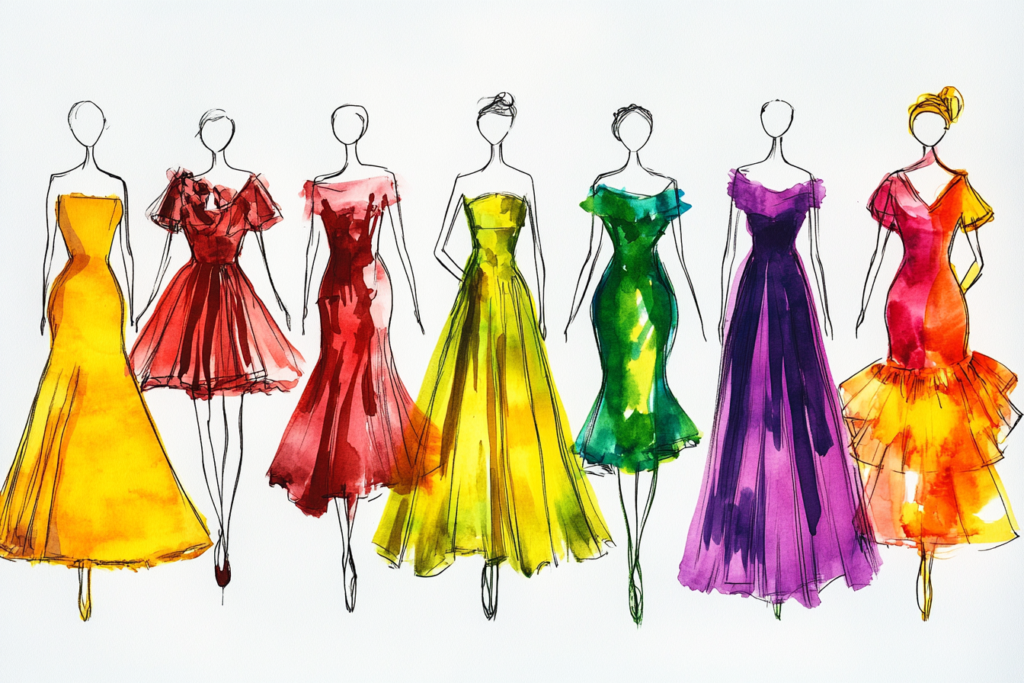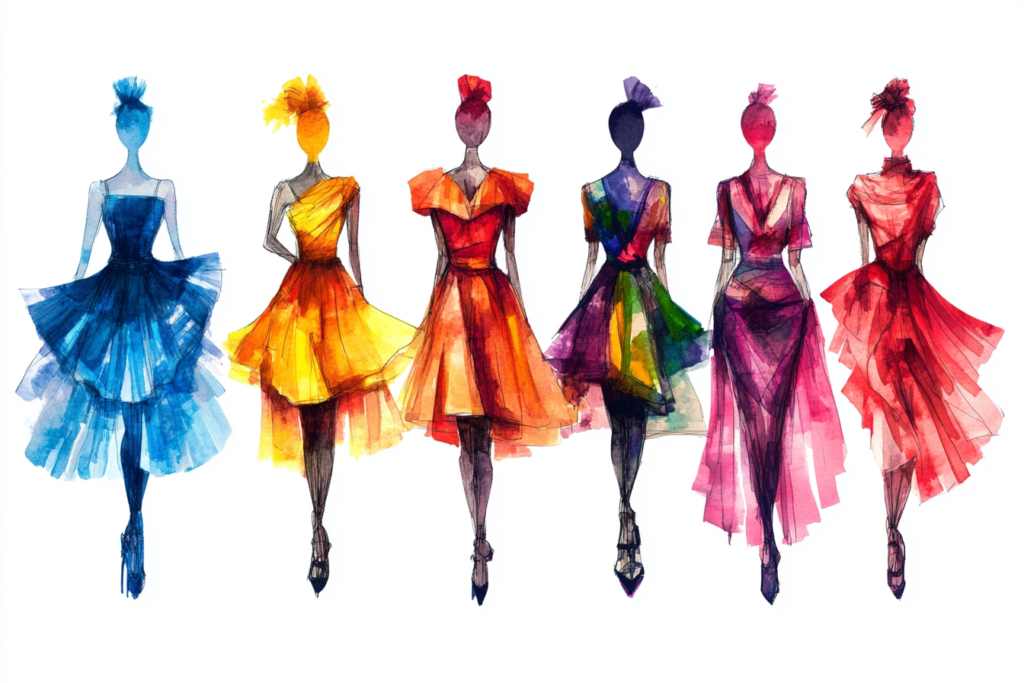Silhouette: Defining the Shape of Your Garment
Meta Description: A silhouette is the outer shape or outline of a garment. Learn how this essential design element influences fashion trends and creates a unique look for different styles of clothing.
What is a Silhouette?
In fashion design, a silhouette refers to the outer shape or outline of a garment. It is the first visual impression of a piece of clothing, outlining how the fabric interacts with the body. The silhouette defines the overall structure of the garment, influencing how it fits, drapes, and flatters the wearer.
From structured, form-fitting shapes to loose, flowing designs, the silhouette is one of the most critical aspects of a garment’s design. It provides a foundation for how the garment will be styled, how it enhances the figure, and the kind of look it projects.


Types of Silhouettes in Fashion
Silhouettes come in a variety of shapes and sizes, each associated with different fashion eras and styles. Here are some of the most common types of silhouettes:
| Silhouette Type | Description |
|---|---|
| A-Line | A shape that gradually flares out from the waist, resembling the letter “A”. Often used in dresses and skirts. |
| Ball Gown | A full, voluminous silhouette, often with a fitted bodice and a dramatic, puffed skirt. Popular in evening wear and formal dresses. |
| Empire | Characterized by a high waistline just below the bust, flowing into a loose skirt. Common in historical garments and bridal wear. |
| Column | A slim, straight silhouette that hugs the body, often used in evening gowns and sleek dresses. |
| Sheath | A fitted, body-hugging silhouette, often knee-length, perfect for formal and professional wear. |
| Fit-and-Flare | Similar to the A-line but with more pronounced flaring from the waist, creating a feminine, hourglass shape. |
| Mermaid | A form-fitting silhouette that hugs the body through the hips and thighs before flaring out dramatically at the knees, often used in evening gowns. |
| Oversized | A loose, relaxed silhouette with no specific shaping, often seen in modern casual or streetwear styles. |
| Straight (Shift) | A simple, straight-cut silhouette that falls from the shoulders to the hem with little or no shaping. Common in retro styles and shift dresses. |
Why is the Silhouette Important?
- Defines Style and Mood
The silhouette is the most immediate visual impression of a garment. It can define the overall style, whether it’s formal, casual, romantic, or dramatic. For instance, an A-line dress suggests a softer, feminine style, while a column silhouette conveys sleek elegance. - Flattering the Figure
The silhouette influences how a garment interacts with the body. Certain silhouettes are designed to accentuate curves, such as the mermaid or fit-and-flare shapes, while others, like the straight or oversized silhouette, are made for a looser, more relaxed look. The right silhouette can enhance body shape and provide a flattering fit for different body types. - Fashion Trend Influence
Silhouettes often reflect the prevailing trends of the time. For example, the 1980s saw a surge in power suits with broad-shouldered silhouettes, while the 1990s embraced the looser, more minimalist straight-leg silhouette. Fashion evolves with new interpretations of silhouettes, influencing what’s trendy. - Fabric and Construction Choices
Different silhouettes require different fabrics and construction techniques to achieve the desired look. For example, a ball gown silhouette needs heavier, more structured fabrics to maintain its voluminous shape, while a column silhouette works best with light, flowing materials that create a streamlined look.
Silhouettes and Fashion History
Throughout history, the silhouette has evolved, often reflecting social changes, technological advancements in fabric, and shifting attitudes toward the body.
- 17th Century (Baroque Period)
During this period, women wore hoop skirts that created an extremely wide silhouette. Men’s fashion also featured broad-shouldered jackets and high collars, creating a dramatic, boxy look. - 19th Century (Victorian Era)
The hourglass silhouette became popular, with tightly fitted bodices and wide skirts (often supported by crinolines) emphasizing the waist. This period’s defining silhouette shaped much of today’s formal and bridal wear. - 1920s (Flapper Style)
The drop-waist silhouette emerged, characterized by loose, straight cuts that hung from the hips. This relaxed, boxy shape was revolutionary compared to the structured looks of earlier decades. - 1950s (Full Skirts and New Look)
Christian Dior’s New Look reintroduced the hourglass silhouette, with full skirts, cinched waists, and feminine shapes. The A-line silhouette became popular as it allowed for movement while still providing a flattering fit. - 1980s (Power Suits and Structured Styles)
The shoulder-padded silhouette dominated women’s fashion, symbolizing empowerment and authority. This era embraced wide, boxy shapes, with jackets and blouses that exaggerated the shoulders to create an angular look.
How to Choose the Right Silhouette for Your Garment
When designing or selecting garments, choosing the right silhouette is critical. Here are some tips:
- Body Shape Considerations:
- For hourglass figures, silhouettes like fit-and-flare or sheath work well.
- Pear-shaped bodies may benefit from A-line skirts or dresses that balance the hips.
- Straight body types might enjoy silhouettes like the empire or ball gown to create more curves and volume.
- Occasion:
- Formal events may call for structured silhouettes like the mermaid or ball gown.
- Casual settings are perfect for looser, more relaxed silhouettes like oversized or shift dresses.
- Fabric Choice:
- Stiff fabrics like taffeta and satin hold their shape better and work well for voluminous silhouettes such as ball gowns.
- Soft, drapey fabrics like silk and chiffon are ideal for sheath or column silhouettes, as they create a fluid, streamlined look.
Conclusion: The Power of Silhouette in Fashion Design
The silhouette is more than just the outer shape of a garment—it is the fundamental structure that defines a garment’s look, feel, and fit. Whether you’re designing a new piece or selecting something from the racks, understanding the influence of silhouette can help you create or choose the perfect garment for any occasion. From the sleek lines of a column silhouette to the dramatic volume of a ball gown, the silhouette not only dictates style but also conveys personality, status, and era.



